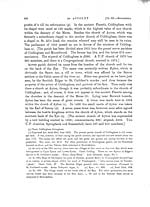Volume 3
(365) Page 353
Download files
Individual page:
Thumbnail gallery: Grid view | List view

353 The parish of EYEMOUTH is one of the smallest in Berwickshire, and the most recent. The village derived its name from its position at the mouth of the Ey river, according to the Northumbrian practice (f). The village and territory of Eyemouth were formerly a part of the barony of Coldingham (g). Since the Reformation, Eyemouth has been made a burgh of barony, under Home of Wed- derburn, who is almost the sole proprietor (h). During the wars which Edward VI. carried on in courtship of Mary Stewart, a fort was built at Eyemouth; was demolished at the peace; and was rebuilt in 1557, amidst some bloody conflicts. In our own times it has become, as we have seen, an useful port of busy traffic (i). [The parish church, erected in 1812, has 164 com- municants; stipend, �379. A Free church (1878) has 234 members; a U.P. church (1842) has 278 members. There is also an Evangelical Union church.] The present parish of MORDING-TON consists of the ancient parishes of Mording- ton and of Lamberton. The first is but an inconsiderable district, which was formed of the barony of Mordington and of the lands of Edrington. In ancient charters, Mordington was written Morthingtoun, and it probably obtained this name from some Saxon settler of the name of Morthin, who communicated his own appellation to his tun or vill. In the ancient Taxatio, the church of Mor- thingtoun was rated at 24 marks (k). The patronage of the church followed the barony till the Reformation. Robert I. gave it to Thomas Randolph, the Earl of Moray, on the resignation of Agnes de Morthington, and Henry Halyburton her husband (I). On the Earl of Moray's death in 1332, this barony descended successively to his two sons, Thomas, the second Earl, who fell at the battle of Dupplin in 1332, and after his death to John, the third Earl, who fell in the disastrous field of Durham in 1346. On this event this barony went to their heroic sister, Black Agnes, the Countess of Dunbar. She seems to (f) In A berdeenshire there is an Eye river, and the place at its issue is named Inver-ey, which signifies in the Gaelic the same as the Saxon Eye-mouth. (g) In 1361, David II. granted to Ade Cossour, a bovate of land in the tenement of Eyemouth, within the barony of Coldingham. Robertson's Index, 82. (k) Stat. Acco., iii., 112. (i) For more particulars of the parish of Eyemouth, the Stat. Acco., iii., 112, may be consulted; and see the Tabular State which is annexed to Berwickshire. (k) Bernard de Lynton, the parson of Mordington, swore fealty to Edward I. on the 24th of August 1296. Prynne, iii., 659. Bernard became abbot of Arbroath about the year 1303. He was appointed chancellor to Robert Bruce in 1307. He celebrated the victory of Bannockburn, 1314, in a Latin poem, a fragment of which has come down to our own times. Fordun, ii., 249. In 1320, he convened the Scottish barons at his monastery of Arbroath, where they subscribed the epistle to the Pope, the magnanimity of which has been admired in every age. Diplom. Scoti�, pl. li. He continued abbot and chancellor till 1328, when he was made bishop of Sodor and Man. He died in 1333, and was buried at Arbroath. (l) Robertson's Index, 9. 3 Z z
Set display mode to:
![]() Universal Viewer |
Universal Viewer | ![]() Mirador |
Large image | Transcription
Mirador |
Large image | Transcription
Images and transcriptions on this page, including medium image downloads, may be used under the Creative Commons Attribution 4.0 International Licence unless otherwise stated. ![]()
| Caledonia, or, An account, historical and topographic of North Britain from the most ancient to the present times > Volume 3 > (365) Page 353 |
|---|
| Permanent URL | https://digital.nls.uk/74528804 |
|---|---|
| Description | Vol. III. |
|---|---|
| Attribution and copyright: |
|

